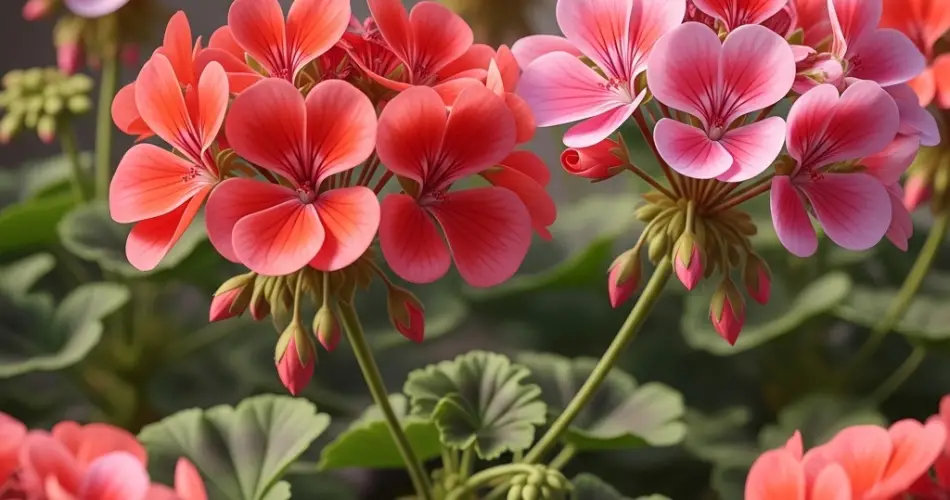Geraniums are beloved for their colorful, long-lasting blooms and low-maintenance nature, making them a favorite for gardeners around the world. Whether planted in pots, hanging baskets, or garden beds, geraniums can bloom almost continuously from spring to fall—if they’re given the right care. If your geraniums have started to slow down or stop blooming altogether, it’s usually due to a few common, easily fixable issues.
Here’s a complete guide on how to encourage nonstop blooms from your geraniums using natural methods and simple gardening practices.
1. Choose the Right Variety
Not all geraniums are created equal when it comes to prolific flowering. The most popular types of blooming geraniums include:
-
Zonal Geraniums (Pelargonium x hortorum): Known for their bright colors and bushy shape. Great for flower beds and containers.
-
Ivy Geraniums (Pelargonium peltatum): Best for hanging baskets, with trailing vines and clusters of delicate blooms.
-
Regal or Martha Washington Geraniums: Produce large, showy flowers but are more finicky about temperature and care.
For continuous blooms throughout the season, zonal and ivy geraniums are your best bet. Choose healthy starter plants or nursery seedlings to give your garden a strong beginning.
2. Provide Full Sunlight
One of the most important factors in getting geraniums to bloom non-stop is sunlight. Geraniums thrive in full sun, needing at least 6 to 8 hours of direct sunlight per day. In lower light conditions, they tend to grow leggy and produce fewer flowers.
Tips for maximum sun exposure:
-
Place pots in a south-facing area or garden bed.
-
If indoors, position geraniums near a bright, sunny window.
-
Rotate pots every few days so all sides of the plant receive light evenly.
3. Use Well-Draining Soil
Geraniums prefer light, well-draining soil that allows oxygen to reach the roots and prevents waterlogging, which can lead to root rot. A good potting mix might include:
-
Regular potting soil
-
Perlite or coarse sand for better drainage
-
A small amount of compost to enrich the soil
Avoid using heavy, clay-like soil, as it can hold too much moisture and stress the plant, reducing its flowering potential.
4. Water Wisely
Overwatering is a common reason geraniums stop blooming. These plants are somewhat drought-tolerant and prefer their soil to dry out between waterings.
Watering guidelines:
-
Check the top inch of soil—only water when it feels dry.
-
Water deeply until water drains out of the bottom of the pot, then allow the soil to dry again.
-
Reduce watering frequency during cooler weather or in shady spots.
Avoid getting water on the leaves to help prevent fungal diseases.
5. Feed for Flowers
Geraniums are moderate feeders and benefit from regular fertilization to sustain blooming. A balanced, water-soluble fertilizer or a formula with more phosphorus (like 10-20-10) will help encourage continuous flower production.
Fertilizing tips:
-
Feed every 2–4 weeks during the growing season (spring to early fall).
-
Avoid over-fertilizing with nitrogen-rich products, as they promote leafy growth at the expense of blooms.
-
Consider using compost tea or diluted fish emulsion as organic alternatives.
6. Deadhead Regularly
Deadheading—removing faded or spent blooms—is one of the easiest and most effective ways to promote continuous flowering in geraniums. When old flowers are left on the plant, energy is diverted toward seed production rather than new buds.
How to deadhead:
-
Pinch or snip off the entire flower stem just above the next set of leaves.
-
Check your plants every few days and remove any faded blooms promptly.
-
Also remove yellowing leaves and any leggy stems to keep the plant looking tidy and healthy.
7. Prune for More Blooms
Geraniums benefit from occasional pruning to encourage bushier growth and more flower buds. Left unpruned, they can become leggy and sparse.
Pruning steps:
-
Use clean scissors or garden shears.
-
Cut back one-third of the plant’s height to promote branching.
-
Perform a light prune mid-season to refresh the plant and boost late-season blooms.
8. Keep Pests and Diseases in Check
Healthy plants bloom more abundantly, so keeping pests and diseases under control is key.
Common issues:
-
Aphids and whiteflies can sap energy from flower production.
-
Botrytis (gray mold) and powdery mildew are common in humid conditions.
Natural solutions:
-
Spray with neem oil or insecticidal soap for pests.
-
Ensure good air circulation around plants.
-
Avoid overhead watering and remove any diseased foliage promptly.
9. Give Them a Rest in Winter
If you live in a region with cold winters, geraniums can be overwintered indoors. While they may not bloom during winter dormancy, giving them a rest will prepare them for an explosion of flowers next season.
Overwintering tips:
-
Bring potted plants indoors before the first frost.
-
Reduce watering and place in a cool, bright location.
-
Prune lightly and resume regular care in early spring.
Final Thoughts
With the right combination of sunlight, proper watering, regular feeding, and a little maintenance, your geraniums can bloom continuously from spring until the first frost. By choosing the right varieties and caring for them naturally, you’ll enjoy an impressive display of color that requires surprisingly little effort. A garden full of thriving geraniums is both beautiful and achievable—even for beginner gardeners.



